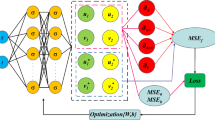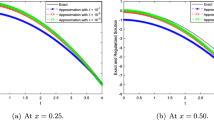Abstract
To further improve the accuracy of the downward continuation of potential field data, we present a novel constrained scheme in this paper combining the ideas of the truncated Taylor series expansion, the principal component analysis, the iterative continuation and the prior constraint. In the scheme, the initial downward continued field on the target plane is obtained from the original measured field using the truncated Taylor series expansion method. If the original field was with particularly low signal-to-noise ratio, the principal component analysis is utilized to suppress the noise influence. Then, the downward continued field is upward continued to the plane of the prior information. If the prior information was on the target plane, it should be upward continued over a short distance to get the updated prior information. Next, the difference between the calculated field and the updated prior information is calculated. The cosine attenuation function is adopted to get the scope of constraint and the corresponding modification item. Afterward, a correction is performed on the downward continued field on the target plane by adding the modification item. The correction process is iteratively repeated until the difference meets the convergence condition. The accuracy of the proposed constrained scheme is tested on synthetic data with and without noise. Numerous model tests demonstrate that downward continuation using the constrained strategy can yield more precise results compared to other downward continuation methods without constraints and is relatively insensitive to noise even for downward continuation over a large distance. Finally, the proposed scheme is applied to real magnetic data collected within the Dapai polymetallic deposit from the Fujian province in South China. This practical application also indicates the superiority of the presented scheme.













Similar content being viewed by others
References
Abedi, M., Gholami, A., & Norouzi, G. H. (2013). A stable downward continuation of airborne magnetic data: A case study for mineral prospectivity mapping in Central Iran. Computers & Geosciences, 52, 269–280.
Agarwal, B. N. P., & Singh, J. (1976). A generalized method for various data processing techniques in gravity interpretation. Pure and Applied Geophysics, 114, 975–982.
Aydin, A. (2007). Interpretation of gravity anomalies with the normalized full gradient (NFG) method and an example. Pure and Applied Geophysics, 164, 2329–2344.
Blakely, R. J. (1995). Potential theory in gravity and magnetic applications. Cambridge: Cambridge University Press.
Clarke, G. K. C. (1969). Optimum second-derivative and downward continuation filters. Geophysics, 34, 424–437.
Cooper, G. (2004). The stable downward continuation of potential field data. Exploration Geophysics, 35, 260–265.
Dampney, C. N. G. (1969). The equivalent source technique. Geophysics, 34, 39–53.
Dean, W. C. (1958). Frequency analysis for gravity and magnetic interpretation. Geophysics, 23, 97.
Dmitriev, V. I., & Dmitrieva, I. V. (2012). Iterative method for analytical continuation of the gravity field. Computational Mathematics and Modeling, 23, 51–55.
Dondurur, D. (2005). Depth estimates for Slingram electromagnetic anomalies from dipping sheet-like bodies by the normalized full gradient method. Pure and Applied Geophysics, 162, 2179–2195.
Fedi, M., & Florio, G. (2001). Detection of potential fields source boundaries by enhanced horizontal derivative method. Geophysical Prospecting, 49, 40–58.
Fedi, M., & Florio, G. (2002). A stable downward continuation by using the ISVD method. Geophysical Journal International, 151, 146–156.
Fedi, M., & Florio, G. (2011). Normalized downward continuation of potential fields within the quasi-harmonic region. Geophysical Prospecting, 59, 1087–1100.
Guspi, F. (1987). Frequency-domain reduction of potential field measurements to a horizontal plane. Geo-exploration, 24, 87–98.
Hansen, R. O., & Miyazaki, Y. (1984). Continuation of potential fields between arbitrary surfaces. Geophysics, 49, 787–795.
Hinze, W. J., & Ralph, R. B. (2013). Gravity and magnetic exploration: Principles, practices and applications. Cambridge: Cambridge University Press.
Konstantinides, K., Natarajan, B., & Yovanof, G. S. (1997). Noise estimation and filtering using block-based singular value decomposition. IEEE Transactions on Image Processing, 6, 479–483.
Li, Y., & Devriese, S. (2009). Enhancement of magnetic data by stable downward continuation for UXO applications. In 79th Annual International Meeting, SEG, pp. 1464–1468.
Liu, D. J., Hong, T. Q., Jia, Z. H., Li, J. S., Lu, S. M., Sun, X. F., et al. (2009). Wave number domain iteration method for downward continuation of potential fields and its convergence. Chinese Journal of Geophysics, 52, 1599–1605.
Meju, M. A. (1994). Biased estimation: A simple framework for inversion and uncertainty analysis with prior information. Geophysical Journal International, 119(2), 521–528.
Nabighian, M. N., Ander, M. E., Grauch, V. J. S., Hansen, R. O., LaFehr, T. R., Li, Y., et al. (2005a). Historical development of the gravity method in exploration. Geophysics, 70, 63–89.
Nabighian, M. N., Grauch, V. J. S., Hansen, R. O., LaFehr, T. R., Li, Y., Pearson, W. C., et al. (2005b). Historical development of the magnetic method in exploration. Geophysics, 70, 33–61.
Naidu, P. S. (1966). Extraction of potential field signal from a background of random noise by Strakhov’s method. Journal of Geophysical Research, 71, 5987–5995.
Oliveira, V. C. J., Barbosa, V. C. F., & Uieda, L. (2013). Polynomial equivalent layer. Geophysics, 78, G1–G13.
Pašteka, R., Karcol, R., Kušnirák, D., & Mojzeš, A. (2012). REGCONT: a MATLAB based program for stable downward continuation of geophysical potential fields using Tikhonov regularization. Computers & Geosciences, 49, 278–289.
Pawlowski, R. S. (1995). Preferential continuation for potential-field anomaly enhancement. Geophysics, 60, 390–398.
Richard, D. R. (1984). Continuation by integral equation methods: A note on surface integration over the double layer. Pure and Applied Geophysics, 122, 725–730.
Tai, Z. H., Zhang, F. X., Zhang, F. Q., & Hao, M. C. (2016). Approximate iterative operator method for potential-field downward continuation. Journal of Applied Geophysics, 128, 31–40.
Tikhonov, A. N., Glasko, V. B., Litvinenko, O. K., & Melikhov, V. R. (1968). Analytic continuation of a potential in the direction of disturbing masses by the regularization method. Izvestiya Physics of the Solid Earth, 12, 30–48.
Trompat, H., Boschetti, F., & Hornby, P. (2003). Improved downward continuation of potential field data. Exploration Geophysics, 34, 249–256.
Uieda, L., & Barbosa, V. C. F. (2012). Robust 3D gravity gradient inversion by planting anomalous densities. Geophysics, 77, G55–G66.
Wang, J., Meng, X. H., Guo, L. H., Chen, Z. X., & Li, F. (2014). A correlation-based approach for determining the threshold value of singular value decomposition filtering for potential field data denoising. Journal of Geophysics and engineering, 11(5), 055007.
Wang, J., Meng, X. H., & Li, F. (2015). Improved curvature gravity gradient tensor with principal component analysis and its application in edge detection of gravity data. Journal of Applied Geophysics, 118, 106–114.
Wang, J., Meng, X. H., & Li, F. (2017). Fast nonlinear generalized inversion of gravity data with application to the three dimensional crustal density structure of Sichuan Basin, Southwest China. Pure and Applied Geophysics, 174, 4101–4117.
Xu, S. Z., Yang, J. Y., Yang, C. F., Xiao, P. F., Chen, S. C., & Guo, Z. H. (2007). The iteration method for downward continuation of a potential field from a horizontal plane. Geophysical Prospecting, 55, 883–889.
Yan, J. Y., Lü, Q. T., Chen, X. B., Qi, G., Liu, Y., Guo, D., et al. (2014). 3D lithologic mapping test based on 3D inversion of gravity and magnetic data: A case study in Lu-Zong ore concentration district, Anhui Province. Acta Petrologica Sinica, 30, 1041–1053.
Yao, C. L., Li, H. W., Zheng, Y. M., Meng, X. H., & Zhang, Y. W. (2012). Research on iteration method using in potential field transformations. Chinese Journal of Geophysics, 55, 2062–2078.
Yuan, Y., Zhang, D., Feng, H. B., Di, Y. J., Wang, C. M., & Ni, J. H. (2014). The Re-Os isotope geochronology of Dapai iron polymetallic ore deposit in Yongding county, Fujian province and its genetic significance. Acta Geologica Sinica, 88, 1025–1026.
Zeng, X. N., Li, X. H., Su, J., Li, D. Z., & Zou, H. X. (2013). An adaptive iterative method for downward continuation of potential-field data from a horizontal plane. Geophysics, 78, J43–J52.
Zhang, H. L., Ravat, D., & Hu, X. Y. (2013). An improved and stable downward continuation of potential field data: The truncated Taylor series iterative downward continuation method. Geophysics, 78, J75–J86.
Zhang, Z., Zuo, R., & Cheng, Q. (2014). The mineralization age of the Makeng Fe deposit, South China: implications from U-Pb and Sm-Nd geochronology. International Journal of Earth Sciences, 104, 663–682.
Zhou, W. N., Li, J. Y., & Yuan, Y. (2017). Downward continuation of potential field data based on Chebyshev–Pade´ approximation function. Pure and Applied Geophysics, 3, 1–12.
Acknowledgements
The authors thank the editors and anonymous reviewers for their constructive comments for improving the paper. This work was supported by (1) the National Natural Science Foundation of China (grant No. 41474106 and 41530321); (2) the National Key R&D Program of China (grant No. 2016YFC0303000).
Author information
Authors and Affiliations
Corresponding author
Rights and permissions
About this article
Cite this article
Wang, J., Meng, X. & Zhou, Z. A Constrained Scheme for High Precision Downward Continuation of Potential Field Data. Pure Appl. Geophys. 175, 3511–3523 (2018). https://doi.org/10.1007/s00024-018-1861-6
Received:
Revised:
Accepted:
Published:
Issue Date:
DOI: https://doi.org/10.1007/s00024-018-1861-6




